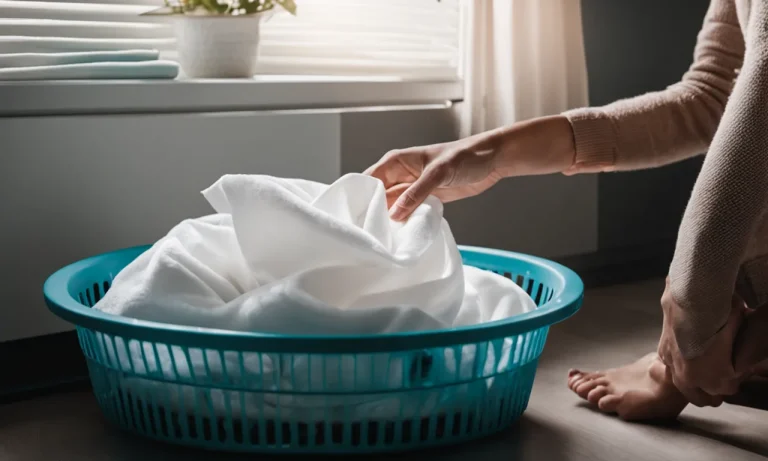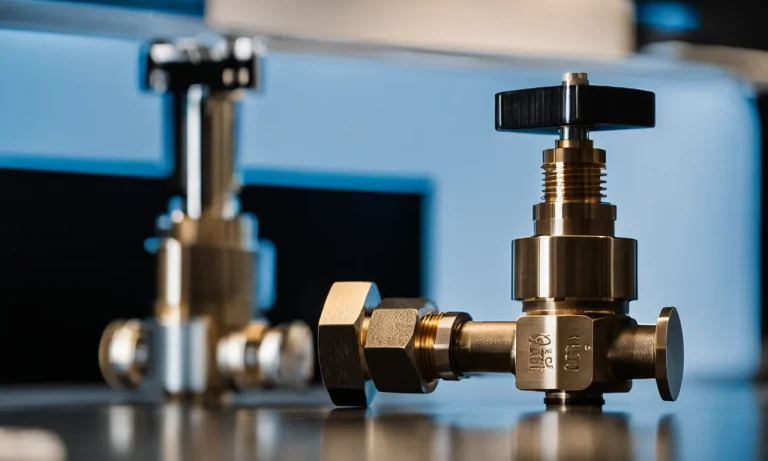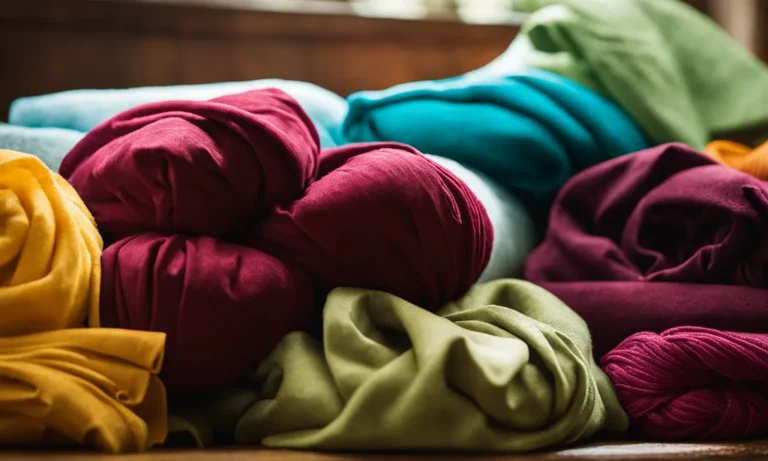What To Do If You Accidentally Used Fabric Softener On Workout Clothes
We’ve all been there – you’re rushing to do laundry and accidentally grab the fabric softener instead of the laundry detergent. Before you know it, your workout clothes have been drenched in fabric softener, leaving them feeling soft and static-y. Yikes!
Fabric softener may make your clothes feel fluffy and fresh, but it’s an absolute no-no for activewear. The chemicals in fabric softener coat the fibers in your workout gear, compromising their ability to wick away moisture.
This can leave you feeling hot, sweaty, and just plain uncomfortable during your fitness routine. But don’t sweat it (pun intended) – with some thorough washing, your workout clothes can be restored. Here’s what you need to know about getting the fabric softener out of your activewear.
If you’re short on time, here’s a quick answer to your question: Re-wash your workout clothes in hot water with an extra rinse cycle and either vinegar or laundry detergent. The heat and extra rinse help remove fabric softener residue, while the vinegar or detergent act as degreasers to cut through the coating on the fibers.
Why Fabric Softener Ruins Workout Clothes
Using fabric softener on workout clothes is a common mistake that many people make without realizing the potential damage it can cause. Fabric softeners are designed to make clothes feel softer and reduce static cling, but they can have detrimental effects on the performance and lifespan of your workout gear.
Here are a few reasons why fabric softener ruins workout clothes:
Coats the fibers and affects moisture wicking
One of the key reasons why fabric softener is harmful to workout clothes is that it coats the fibers of the fabric. This coating can hinder the fabric’s ability to wick away moisture, which is essential for keeping you cool and dry during your workouts.
Moisture-wicking fabrics are specially designed to pull sweat away from the body and allow it to evaporate quickly, helping to regulate body temperature. When fabric softener is used, it creates a barrier on the fabric, preventing it from effectively wicking away moisture.
Causes buildup and clumping
Fabric softener can also cause buildup and clumping in workout clothes. This is especially problematic for garments that have compression or stretch properties. The softening agents in fabric softener can accumulate in the fabric, causing it to lose its elasticity and become stiff.
This can make it difficult to move freely and comfortably during exercise. Additionally, the buildup can lead to the formation of clumps or lumps in the fabric, affecting the overall appearance and performance of the clothing.
Makes fabrics more flammable
Another concerning aspect of using fabric softener on workout clothes is that it can make the fabrics more flammable. Fabric softeners often contain chemicals that can increase the flammability of certain materials.
Since workout clothes are typically made from synthetic fabrics like polyester or nylon, which are already more prone to melting and burning, using fabric softener can further increase the risk of fire hazards.
It is important to prioritize safety when it comes to choosing laundry products for your workout clothes.
How to Remove Fabric Softener from Workout Clothes
Accidentally using fabric softener on your workout clothes can leave them feeling greasy and less effective at wicking away sweat. But don’t worry! There are several methods you can try to remove the fabric softener and restore your activewear to its original performance.
Re-wash in hot water with an extra rinse cycle
If you’ve just discovered the fabric softener mishap, the first step is to re-wash your workout clothes in hot water with an extra rinse cycle. Hot water can help break down the fabric softener residue, while the additional rinse cycle helps to flush it out completely.
Make sure to avoid using any fabric softener or dryer sheets during this wash.
Use vinegar or laundry detergent as a degreaser
If the fabric softener residue persists, you can try using vinegar or laundry detergent as a degreaser. Add about a cup of distilled white vinegar or a small amount of laundry detergent to a sink or basin filled with warm water.
Soak your workout clothes in the mixture for about 30 minutes, then rinse thoroughly.
Try a laundry stripping soak
In some cases, fabric softener can build up over time and require a more intensive cleaning method. One option is to try a laundry stripping soak. Fill a bathtub or large basin with hot water, add a mixture of laundry detergent, borax, and washing soda, and let your workout clothes soak for several hours or overnight.
After soaking, rinse thoroughly and wash as usual.
Use a laundry booster or clarifying detergent
If the above methods don’t fully remove the fabric softener residue, you can try using a laundry booster or clarifying detergent. These products are designed to remove buildup and residue from fabrics. Follow the instructions on the product packaging for best results.
Hand wash delicate activewear
If you’re dealing with delicate or sensitive workout clothes, such as those made from merino wool or with special moisture-wicking properties, it’s best to hand wash them. Fill a sink or basin with cool water and a small amount of gentle detergent.
Gently agitate the clothes and let them soak for a few minutes before rinsing thoroughly.
Remember, prevention is key! To avoid future mishaps, always check the labels on your workout clothes for fabric softener warnings, and separate them from your regular laundry to prevent accidental exposure.
How to Prevent Using Fabric Softener on Workout Clothes
Store laundry products separately
One of the best ways to prevent accidentally using fabric softener on your workout clothes is to store your laundry products separately. By keeping your fabric softener in a different location than your detergent, you reduce the chances of grabbing the wrong bottle in a rush.
Consider designating separate shelves or bins for each type of product to make it easier to differentiate between them.
Label containers clearly
Another helpful tip is to label your laundry containers clearly. Use stickers or labels to clearly mark which bottle contains fabric softener and which one contains detergent. This simple visual cue can help you quickly identify the right product to use on your workout clothes and avoid any mishaps.
Pay attention while doing laundry
While it may seem obvious, paying attention while doing laundry is crucial. It’s easy to become distracted and accidentally grab the fabric softener instead of the detergent. Take a moment to double-check the bottle before adding it to the washing machine.
By staying present and focused, you can prevent using fabric softener on your workout clothes.
Wash activewear separately
To further minimize the risk of using fabric softener on your workout clothes, consider washing your activewear separately from your regular laundry. This not only reduces the chances of mixing up your laundry products but also helps protect the integrity and performance of your workout gear.
Washing activewear separately can help maintain its moisture-wicking properties and prevent any unwanted residue from fabric softener.
Remember, fabric softener can leave a residue on workout clothes, which can hinder their ability to wick away moisture and odor. By following these preventive measures, you can ensure that your workout clothes stay fresh, odor-free, and in optimal condition for your next sweat session.
When to Replace Your Workout Clothes
Workout clothes are an essential part of any fitness routine. They help us stay comfortable, dry, and stylish during our workouts. But what happens when we accidentally use fabric softener on our beloved activewear? Don’t worry, we’ve got you covered!
Here are some signs that it might be time to replace your workout clothes.
Fabric smells bad even after rewashing
One of the first signs that your workout clothes might need replacing is if they continue to smell bad even after being washed. This can happen if fabric softener has been used on them. Fabric softeners can leave a residue on the fabric that traps odors, making it difficult to completely remove them.
If you’ve tried rewashing your clothes multiple times and they still smell, it might be time to invest in some new activewear.
Clothes feel stiff and crunchy
Another indication that it’s time to replace your workout clothes is if they feel stiff and crunchy. Fabric softeners can leave a coating on the fabric that can make it feel rough and uncomfortable against your skin.
If your clothes no longer have that soft and flexible feel, it’s a good idea to start shopping for new ones.
Moisture wicking properties are compromised
One of the key features of workout clothes is their ability to wick away sweat and moisture, keeping you cool and dry during your workouts. However, using fabric softener on your activewear can compromise this moisture-wicking property.
The softener can create a barrier on the fabric that prevents it from effectively pulling sweat away from your body. If you find that your clothes are no longer keeping you dry and comfortable, it might be time to invest in some new ones.
Fabric pills easily
Have you noticed small balls of fabric forming on your workout clothes? This is called pilling and it can happen when the fabric becomes worn or damaged. Using fabric softener can actually accelerate the pilling process, causing your clothes to look worn out and old before their time.
If your clothes are pilling easily, it’s a good indication that it’s time to replace them.
The Takeaway
Summarize key points
Accidentally using fabric softener on workout clothes can have negative effects on their performance and longevity. Fabric softeners contain chemicals that can create a coating on the fabric, reducing its ability to wick away moisture and breathe properly.
This can lead to sweat being trapped against the skin, causing discomfort and potentially leading to odor and bacteria buildup. It’s important to take immediate action to remove the fabric softener from your workout clothes to prevent these issues.
Reiterate importance of removing fabric softener
Removing fabric softener from workout clothes is crucial to maintain their functionality and performance. One method to remove fabric softener is to run the clothes through a regular wash cycle without any detergent or fabric softener. This helps to rinse out the residue left by the fabric softener.
Alternatively, you can soak the affected clothes in a mixture of vinegar and water for about 30 minutes before washing them. Vinegar helps to break down the fabric softener and remove it from the fabric fibers.
Remember, fabric softener is designed to make clothes feel soft and smell good, but it is not suitable for all types of fabrics, especially those used in workout clothes. By removing fabric softener from your workout clothes, you can ensure that they continue to perform at their best and last longer.
Encourage readers to carefully do laundry moving forward
To avoid any future mishaps, it’s important to carefully read and follow the care instructions on your workout clothes. These instructions provide guidance on the best practices for washing and caring for the specific fabric and garment.
Additionally, consider using a detergent specifically designed for activewear, as these detergents are formulated to effectively clean and remove odors from workout clothes without leaving behind any residue.
By taking these precautions and being mindful of the products you use when washing your workout clothes, you can ensure that they stay in great condition and continue to provide you with the performance and comfort you need during your workouts.
Conclusion
We all make laundry mistakes from time to time. The important thing is catching those slip-ups quickly and taking steps to fix them. With some strategic washing, you can get your workout gear feeling fresh again after an accidental fabric softener encounter.
Just be sure to keep the fabric softener far away from your activewear from now on! Taking a few precautions can help keep your workout clothes wick, odor-free, and ready to handle even your sweatiest gym sessions.







